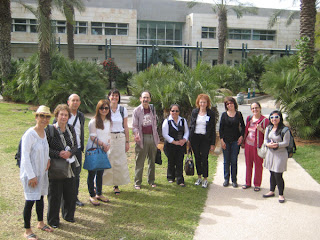[audio mp3="http://web.macam.ac.il/~jhurvitz/english/traveling-broadens-one.mp3"][/audio]
Seven full days of traveling, lectures, discussions, and more came to an end with a certificate ceremony. Each participant was called to the front of the room and was presented with a "diploma", and of course also with a handshake and a hug.
And though the tour at that point was officially over, we still had one more activity waiting for us. We taxied to Yaffo where we toured the town along with Sharona whom we'd been with in Jerusalem. This was our opportunity for one last group photo.
And to finish the day, and the tour, we ate dinner at Na LaGa'at where we learned a bit of sign language, and also saw the Luna Park performance. When we got back to the hotel it was time for one last hug and goodbye.
But we have no doubt that we'll find ways to maintain contact.
And though the tour at that point was officially over, we still had one more activity waiting for us. We taxied to Yaffo where we toured the town along with Sharona whom we'd been with in Jerusalem. This was our opportunity for one last group photo.
And to finish the day, and the tour, we ate dinner at Na LaGa'at where we learned a bit of sign language, and also saw the Luna Park performance. When we got back to the hotel it was time for one last hug and goodbye.
But we have no doubt that we'll find ways to maintain contact.



















































